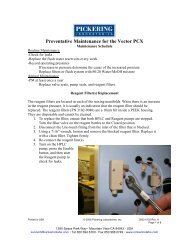to download our North American Product Catalog - Pickering ...
to download our North American Product Catalog - Pickering ...
to download our North American Product Catalog - Pickering ...
You also want an ePaper? Increase the reach of your titles
YUMPU automatically turns print PDFs into web optimized ePapers that Google loves.
METHOD ABSTRACTS123 / SIMULTANEOUS DETERMINATION OF NITRITE AND NITRATE IN PROCESSED FOODSSIMULTANEOUS DETERMINATION OF NITRITE AND NITRATE IN BABY FOODSSaji George, Maria Otserova, Ph. D., Michael <strong>Pickering</strong>, Ph. D.Nitrite either alone or in combination with nitrate is added <strong>to</strong> food <strong>to</strong> preserve the color and taste and <strong>to</strong> prevent foods frombecoming rancid. They are also used in food for their anti-microbial properties. Higher levels in vegetables and leafy greensare possible from the use of nitrate fertilizers and/or lives<strong>to</strong>ck manure.Nitrate can be reduced <strong>to</strong> nitrite at certain physiological conditions in the human body. Nitrite however can oxidize Fe (II) inhemoglobin <strong>to</strong> methemoglobin, an Fe (III) product. The oxidized product is incapable of binding molecular oxygen andhigh concentrations of methemoglobin can result in methemoglobinemia especially in infants. Nitrite can also react withsecondary amines present in food products or in the digestive system <strong>to</strong> form nitrosamines, a class of carcinogenic compounds.Nitrite levels in food could also be produced by reduction of nitrate <strong>to</strong> nitrite during processing.The AOAC Ofcial Method 993.03 1 for the analysis of nitrate involves reduction using spongy Cadmium which is <strong>to</strong>xic andcarcinogenic. The USFDA improved on this method by using Vanadium (III) chloride and heat 2 for the post-column reductionof nitrate <strong>to</strong> nitrite. Nitrite reacts with this modied Griess reagent <strong>to</strong> produce a red chromophore with maximal absorbanceat 535 nm. <strong>Pickering</strong> Labora<strong>to</strong>ries Inc. has further improved this method by substituting the corrosive and volatilehydrochloric acid with methane sulfonic acid.METHODEquipment• LC with a binary pump• UV/VIS detec<strong>to</strong>r• <strong>Pickering</strong> Labora<strong>to</strong>ries single reagent Pinnacle PCXpost-column derivatization unit(1153-1021 - 120 V, 1153-1022 – 240 V)• <strong>Pickering</strong> Labora<strong>to</strong>ries anion exchange column,4.6 X 150 mm (Cat. No. 0785150)Chemicals• Sodium acetate• Vanadium(III)chloride• N-(1-Naphthyl)ethylenediamine dihydrochloride• m-Nitro aniline• 20 %(v/v) methane sulfonic acidLC ConditionsSample Injection Volume: 10 µLLC Flow Rate: 1 mL/minMobile Phase: 0.15 M sodium acetatePost-column ConditionsColumn Temperature: 50 °CReac<strong>to</strong>r Volume: 0.5 mLReac<strong>to</strong>r Temperature: 100 °CReagent Flow Rate: 0.1 mL/minReagent:Mix 50 mL of (i) and (ii), and 1.25 mL of (iii) and dilute <strong>to</strong>250 mL using 20 % methanesulfonic acid[ (i) 1 % Vanadium(III)chloride in 20 % methanesulfonicacid,(ii) 1 % m-Nitro aniline in 20 % methanesulfonic acid,(iii) 1 % N-(1-Naphthyl)ethylenediamine dihydrochloride in20 % methanesulfonic acid ]Detec<strong>to</strong>r: UV/VIS, max= 535 nmExtraction ProcedureFruits and VegetablesTo 5 g of baby food in a 50 mL centrifuge tube add 25mL of 50-60 ºC water (for vegetables) or 15 mM Sodiumacetate (for fruits) and shake for 10 min. Add 12.5 mL oface<strong>to</strong>nitrile and make up the volume <strong>to</strong> 50 mL using water(for vegetables) and sodium acetate (for fruits). Centrifugethe mixture for 15 mins at 5000 rpm. Filter the supernatantthrough a 0.45 µ nylon lter and dilute <strong>to</strong> fall within thelinear range.Processed MeatTo 5 g of homogenized processed meat in a blender add 25mL of 50-60 ºC water and blend for 2 min. Add 25 mL oface<strong>to</strong>nitrile and blend for an additional 2 min. Transfer in<strong>to</strong>a beaker and make up the volume <strong>to</strong> 100 mL using warmwater. Filter themixture using Whatman lter paper. Filter further through a0.45 µ nylon lter and dilute <strong>to</strong> fall within the linear range.NOTESPost-column reagent solutions are s<strong>to</strong>red in plastic containers.All solutions are fi ltered through 0.45 µ nylon fi lter before use.Nitrate/Nitrite standards should be checked prior <strong>to</strong> use for oxidation.Sample pH should be checked <strong>to</strong> determine the choice of extraction solutionsince acidic pH facilitates the conversion of nitrite <strong>to</strong> nitrate.119Continued on next pagePRODUCT CATALOGPICKERING LABORATORIES10/11



